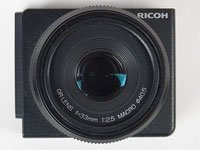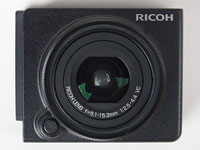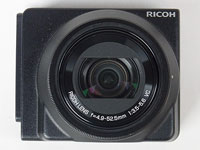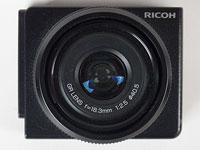Ricoh GXR: Units - Overview
Introduction | A12-50 | S10 24-72 | P10 28-300 | A12-28 | M-Mount | A16 24-85 | Rumors | Conclusions
Archive
On this page, I provide an overview of the Ricoh GXR camera units (Ricoh speak), also called lensors or modules. There are five camera units and one expansion unit that I will briefly describe below. Note that for each of the units there is also a more detailed page. In addition, I offer links to information provided by Ricoh and on this site. I also include a few personal conclusions regarding the units.
Note: Although there is still no official confirmation from Ricoh, it seems that Ricoh let the GXR system slowly and quietly die in 2013/2014...
Introduction
The Ricoh GXR is a mirrorless system camera that differs from all other system (or EVIL) cameras in that not lenses but camera units (or modules) are being exchanged. These are integrated lens-sensor units, also called "lensors". The system currently consists of a body, five camera units, and one expansion unit. The latter contains only a sensor and accepts Leica M-bayonet (or M-mount) lenses.
Ricoh provides a number of arguments for the superiority of this concepts, but these have been questioned for a number of reasons. Here are some of the arguments that Ricoh provides:
- Sensors allow an optimal adaptation of sensor to lens.
- Different sensor sizes allow for optimal solutions, for example small lenses for the tele range using small sensors.
- Dust protection: The sensor is never exposed (exception: the M-mount unit).
Among the counter arguments are:
- Camera units are more expensive than lenses alone.
- Sensors outdate sooner than lenses, requiring users to update their units more often than would be needed for lenses.
- Dust protection: Some of the lens designs, particularly those for small sensors, are "wobbly" designs and sensitive to "sucking in" dust (there were already many dust issues reported in discussion boards on the Internet, and I had one myself...).
Many reviewers regard(ed) the GXR system as exotic, to say the least...
GXR History
When the Ricoh GXR was released in December 2009, just two camera units were available: the A12-50 unit, and the S10 unit. The A12-50 features an APC-C size sensor, an equivalent focal length of 50 mm, and includes a macro function. The S10 is more or less a GX200 or GX100 with an equivalent focal length of 24-72 mm (the pixel count is the same as for the GX100).
At the end of May 2010, a third camera unit was released, which is more or less a CX3ff with an equivalent focal length of 28-300 mm and the addition of the RAW format (DNG). In November 2010, the A12-28 camera unit was released, which offers a feature set similar to the A12-50, but does not have a macro mode.
For 2011, an M-mount expansion unit and a 24-28 APS-C zoom camera unit were - more or less - announced. The M-mount unit was released at the beginning of September 2011, the only new unit in 2011.
Ricoh showed a "secret" unit roadmap at Photokina 2010 that already hinted at the APS-C zoom. They published an official unit roadmap in December 2011 that contains the zoom, then called A16 24-85. Here is (for copyright reasons) only a simplified version of the roadmap (with corrections regarding the conversion lenses):
Lens |
Sensor |
... |
20 mm |
50 mm |
100 mm |
200 mm |
300 mm |
... |
Conversion Lens |
|
| Camera Unit |
GR lens | APS-C CMOS | A12 28 F2.5 |
A12 50 F2.5 Macro |
||||||
| Ricoh lens | APS-C CMOS | |||||||||
| 1/1.7 CMOS | S10 24-72 F2.5-4.4 VC |
DW-6 (0.79x, wide), TC-1 (1.88x, tele) |
||||||||
| 1/2.3 CMOS | P10 28-300 F3.5-5.6 VC |
|||||||||
| Expansion Unit | APS-C CMOS | GXR Mount A12 (M-mount) |
||||||||
Figure: Simplified and slightly corrected version of Ricoh's unit roadmap published at the end of 2011 (original unit map at Ricoh)
The A16 24-85 camera unit was officially announced at the beginning of February 2012 and became available in Germany at the end of March 2012.
There was more or less silence in 2012 from Ricoh regarding the future of the GXR system. The silence around the GXR continued in 2013 and the beginning of 2014, at least, on Ricoh's side. In the end, several sales actions and the lack of news were strong indicators that Ricoh actually discontinued the GXR in 2013 or 2014, although still some modules are listed on the Ricoh Website.
In the following, I will list the available units and provide links to more information about them.
A12-50
The A12-50 camera unit contains an APS-C size sensor (CMOS, total pixels: approx. 12.9 million, effective pixels approx. 12.3 million) with a focal length of 33 mm that is equivalent to 50 mm. It corresponds to a standard lens for a (D)SLR camera and features a macro mode allowing magnifications up to 1:2 (the closest distance is 7 cm). It has a focus ring, which regrettably does not operate manually, but "by wire." There are also no depth of field indicators on the lens body, but depth of field information is provided in the viewfinder and on the LCD screen when focusing manually. Also note that A12 camera units do not incorporate a vibration correction (also called anti-shake correction).
Photo: GR Lens A12-50 mm equiv. F2.5 MACRO
This camera unit is able to capture videos in HD 720p format.
Links
- Technical data: ricoh.com/r_dc/gxr/specs.html#04
- Description: ricoh.com/r_dc/gxr/unit.html
- Sample photos: ricoh.com/r_dc/gxr/sampleimage.html
- More information and my experience with the module (on this site)
S10 24-72
The S10 camera unit is more or less a Ricoh GX200/100 in a GXR format, featuring an equivalent focal length of 24-72 mm and a 1/1.7" CCD sensor (total pixels: approx. 10.4 million). As it has a small sensor, its image quality is not on par with the A12's. This has led many reviewers to conclude that this unit is a "disappointment" because its image quality corresponds to that of a small sensor camera. However, if you do not expect DSLR quality from this unit and know what to expect, it is perfectly fine - it's just a bulkier GX200/100 with a better viewfinder...
The focal range of the S10 camera unit can be extended with two converters. with the DW-6 at the wide end (0.79x, 19 mm equiv.), and with the TC-1 at the tele end (1.44x, 135 mm equiv.). This extends the unit's zoom range from 3x (24-72 mm) to 7x (19-135 mm).
Please note that you also need the HA-3 lens hood to use the two converters.
There is a LC-2 lens cap for the S10 unit that can be kept on the lens while shooting. Note that it cannot be used with the HA-3 lens hood and the converters.
Photo: Ricoh Lens S10 24-72 mm equiv. F2.5-4.4VC
Links
- Technical data: ricoh.com/r_dc/gxr/specs.html#06
- Description: ricoh.com/r_dc/gxr/unit2.html
- Sample photos: ricoh.com/r_dc/gxr/sampleimage.html
- More information and my experience with the module (on this site)
This camera unit captures videos in VGA format at maximum.
P10 28-300
Long ago, I bought one of the first "superzooms" with a focal range of 28-200 mm for my analog Canon A1. In the new millennium, I switched from Nikon to the Minolta Dimage 7 series of bridge cameras having the same focal range. When I stepped up to DSLRs, I bought a Sigma 18-200 lens, featuring an equivalent focal range of 28-300 mm. Now, I own a P10 module with just the same focal range and a tiny 1/2.3" CMOS sensor (total pixels: approx. 10.60 million pixels). Thus, in a certain sense, I have returned to where I had been before, and in another one not, because this is a small sensor module.
I also led my wife to use Ricoh cameras, starting with a focal range of 28-200 mm. In 2010, she stepped up from her CX1 to a CX4, which also has a focal range of 28-300 mm (this range was introduced with the CX3). Thus, with the P10 unit, I have a camera very similar in operation to my wife's one. There are, however, some important differences:
- The GXR is much more bulkier than the CX3ff. While the latter easily fits a pocket, the GXR/P10 combo does not, particularly, when I use it with the electronic viewfinder VF-2.
- For me it is mandatory that there is an electronic (or optical) viewfinder that I can use at eye-level (so I need not use glasses). The CXff has only an LCD screen that can often be hard to use in direct sunlight.
- The GXR offers RAW, a capability that has often been demanded for the R/CX series, but never materialized.
- The GXR also offers manual settings (A, S, and M mode) which the R/CX series does not offer (the recent CX6 offers some sort of A and S modes)
- Some forum posters state that the overall image quality of the P10 is slightly better than that of the CX series.
The LC-2 lens cap can be used on the P10 unit as well. It can be kept on the lens while shooting.
Photo: Ricoh Lens P10 28-300 mm equiv. F3.5-5.6 VC
The P10 camera is able to capture videos in HD 720p format.
Links
- Technical data: ricoh.com/r_dc/gxr/specs.html#08
- Description: ricoh.com/r_dc/gxr/unit3.html
- Sample photos: ricoh.com/r_dc/gxr/sampleimage.html
- More information and my experience with the module (on this site)
A12-28
The A12-28 camera unit contains an APS-C size sensor module (CMOS, total pixels: approx. 12.9 million, effective pixels approx. 12.3 million) with a focal length of 18.3 mm that is equivalent to 28 mm. It corresponds to a modest wide angle lens for a (D)SLR. It has a focus ring, which regrettably is not manual, but "by wire." There are also no depth of field indicators on the lens body, but depth of field information is provided in the viewfinder and on the LCD screen when focusing manually. Also note that A12 camera units do not incorporate a vibration correction (also called anti-shake correction).
Photo: GR Lens A12 28 mm equiv. F2.5
This camera unit is able to capture videos in HD 720p format.
Links
- Technical data: ricoh.com/r_dc/gxr/specs.html#10
- Description: ricoh.com/r_dc/gxr/unit4.html
- Sample photos: ricoh.com/r_dc/gxr/sampleimage.html
- More information and my experience with the module (on this site)
M-Mount
The GXR M-mount expansion unit accepts manual lenses with the Leica M-bayonet. It has an adapted APS-C size sensor module (CMOS, total pixels: approx. 12.9 million, effective pixels approx. 12.3 million). Thus, the sensor is not quite identical to that of the other two A12 units. It is supplied with additional micro lenses to perform better with M-bayonet lenses. Moreover, the unit does not have an AA filter. Note that A12 camera units do not incorporate a vibration correction (also called anti-shake correction).
The unit was announced at the beginning of August 2011 and was available from September 9, 2011 on, but only for a short time (the reasons for the shortage were debated...). In the meantime, it is available again.
Some features:
- Focus assist view for manual focusing (two approaches)
- Two shutters: 1/4000 - 180s shutter speed (1/8000th - 1s in electronic shutter mode)
- User-defined distortion, vignetting, and corner color correction, recordable for multiple lenses
With the M-mount expansion unit, the GXR really becomes a "camera construction kit". There are: the GXR body, the electronic viewfinder EV-2, the M-mount unit, and the many, many M-bayonet lenses (plus other units that you may own)...
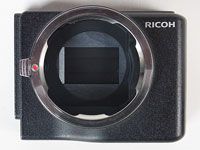 |
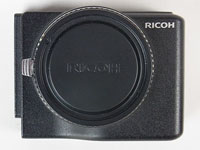 |
Photo: Ricoh A12 M-mount expansion unit
Ricoh publishes a list of approved lenses at the bottom of their M-mount unit page (Mounting Check Results for Each Lens). In addition, they supply a "check device" with the M-mount unit that you can use to check whether the rear part of a lens protrudes too far so that it might damage the sensor. There is also a list of (in)compatible lenses at Ricohforum that is continually updated and much more useful than Ricoh's own list.
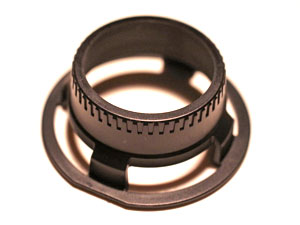 |
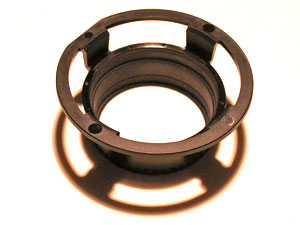 |
Photos: The check device that Ricoh supplies with the M-mount expansion unit
This unit is able to capture videos in HD 720p format.
Links
- Technical data: ricoh.com/r_dc/gxr/specs.html#14
- Description: ricoh.com/r_dc/gxr/unit5.html
- DPR preview: www.dpreview.com/previews/ricohgxrmounta12
- More information and my experience with the module (on this site)
A16 24-85
This camera unit came to the attention of GXR owners when Ricoh showed a "secret" unit roadmap at Photokina 2010 that already hinted at the zoom. In December 2011, Ricoh published an official unit map (see also above) that contains the zoom but gave away only limited information. Finally, at the beginning of February 2012, Ricoh officially announced the unit. It became available in late March in Germany (I received mine on March 23, 2012).
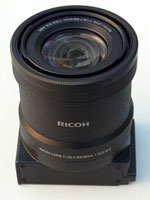 |
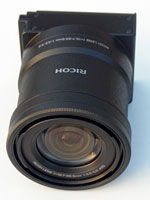 |
Photo: Ricoh Lens A16 24-85 mm equiv. f/3.5-5.5
The camera unit appeared a bit large on the photos that were published before its release, and indeed it is, particularly when zoomed to tele. It weighs 350 g and does not feel heavy "thanks" to being built mostly from plastic, which is OK for me. Regrettably, it neither has a focus nor a zoom ring. It also does not offer a macro function, but it allows to take photos from a minimum distance of 25 cm, which makes it quite useful for closeups with tele. Like other A camera units, it does not provide vibration correction. The APS-C sensor offers 16.2 Megapixels and, like the M-mount expansion unit, lacks an AA filter.
This camera unit is able to capture videos in HD 720p format.
Links
- Technical data: ricoh.com/r_dc/gxr/specs.html#15
- Description: ricoh.com/r_dc/gxr/unit6.html
- Sample photos: ricoh.com/r_dc/gxr/sampleimage.html
- More information and my experience with the module (on this site)
Rumors
The M-mount unit raised the interest in the Ricoh GXR again, but became already unavailable soon after its release. This led to speculations, one of them being that Sony no longer manufactures the 12 Megapixels sensor used in the A camera units and that Ricoh will announce new A16 camera units in 2012. These are said to feature the Sony 16 Megapixels sensor that is used in the Sony Nex5N. While many posters in the forums eagerly await the new, improved sensor, others expressed that are not that happy about their A12 units becoming obsolete soon, particularly the just recently acquired M-mount unit. This rumor was also fuel for those who criticized that sensors become more quickly obsolete than lenses... Anyway, the unit became available again and none of these rumors proved to be true. There was more or less silence in 2012 from Ricoh....
Actually, the silence around the GXR continued in 2013 and the beginning of 2014, at least, on Ricoh's side. In the end, several sales actions and the lack of news were strong indicators that Ricoh actually discontinued the GXR in 2013, although still some modules are listed on the Ricoh Website.
Conclusions
Update: Which unit should I buy? This question has now become one for those users who know the Ricoh GXR and value its unique characteristics. All other users will no longer ask this question and consider cameras that have not been discontinued (as the GXR probably has been...).
Original text:
Which unit should I buy? This is really a tough question, and you should also read my experiences with the units. First of all, your personal shooting habits and preferences should determine which unit you choose.
When the Ricoh GXR was initially released at the end of 2009, there were just two units available, the A12-50 and the S10. More professionally inclined people bought the A12-50, some others (like me) even bought both. Probably, only a few people started with the S10 alone (maybe, Joel Stern, the ubiquitous dpreview poster, did so...).
This is what I answered to the question "S10 or P10?" in a forum to a former GX200 user:
- I own both units, and since I've got the P10, I rarely use the S10 anymore - even though I had a GX100/200 before the GXR. It's simply more flexible (larger focal range, tele macro usable, speed, dynamic range, ...), just like a "Suppenzoom" for a DSLR... Image quality seems to be a bit higher for the S10 because of the slightly larger sensor, and you get more at the wide angle end (24 mm and 19 mm with converter) with it. Thus, if you like dramatic photos of the sky, the S10 would be the one for you. And of course, there will be little change from your GX200, which may also be important.
After the P10 unit was released and the price for the body/P10 combo drastically reduced, this combo became probably the most universal and "economic" entry into the GXR system, even though nearly 500 EUR/$ may still seemed steep for a small sensor camera. In the meantime, I have become somewhat spoilt by the superior quality and sharpness of the A12 units and find the images taken with the P10 module fuzzy. There are also definite differences in how the APS-C units render faces and other details compared with the small-sensor units (and the respective point-and-shoot cameras from Ricoh). Thus, the P10 units lost some of its appeal for me... In 2011, I experimented with the M-mount unit, and in 2012 the A16 24-85 unit became my favorite unit - despite some fuzziness in the corners.
A New Camera - The GXR with M-Mount Expansion Unit
The M-mount expansion unit is being delivered since the 9th of September, 2011, however in low quantities only. I received mine in mid October. This unit defines the GXR in a completely new way, because with the body and this unit you can use it as a kind of Leica replacement with manual M-bayonet lenses, thus turning it into something like a "manual system camera" or even a kind of "small manual DSLR replacement". In this configuration, it comes close to what I had looked for when I sold my DSRL equipment and wanted to move to something smaller but with similar capabilities. There are, however, some gaps that need to be covered with other units: no macro, no "real" tele, no sports capabilities... After playing around with this combination, I, however, became lazy again and preferred and mostly used the new A16 24-85 unit.
Other Combinations
Interestingly, the A16 24-85 mm APC-C sensor zoom unit is not of an GR lens type, that is, it seems to have a lower image quality than the A12 units. On the other hand, it is the first unit with a new Sony 16 Megapixels sensor. This unit moves the GXR into another direction than the M-mount unit: It turns the GXR into a flexible vacation camera, although it is still a little bit short at the tele end. Thus, when using it you need to take the P10 with you for tele and macro shots. But this comprises still a fairly lightweight package compared with the M-mount package. Therefore, I took this combination with me on my vacations in summer 2012 and in spring 2013.
A similar package could be made from the S10 and the P10, which would even be lighter (and with a DW-6 also have more range at the wide end). However, the difference in image quality between both units is not that large. Therefore, one might consider using the P10 alone for the same purpose...
Sometimes, I take the A12-28 and A12-50 with me on walks. I found this to be a very versatile combination that includes macro. A P10 in the bag would add weight but also tele facilities and even more magnification for macro shots.
Finals Words...
All in all, the GXR units offer quite a few options for combining units to take with you. The most severe gap is in my opinion the lack of high-quality options in the tele range, but as I read in Ricoh forums, many users can do without a tele lens. Perhaps, there is already too much competition between units so that it is hard for you to decide, which one to use. Many GXR users seem to take with them just one fixed focal length lens on the camera and put another one into the pocket. This is what I also do often, but mostly I take all my photos with just one focal length. It's restricting, but also demanding and fun.
| 19.11.2020 |
